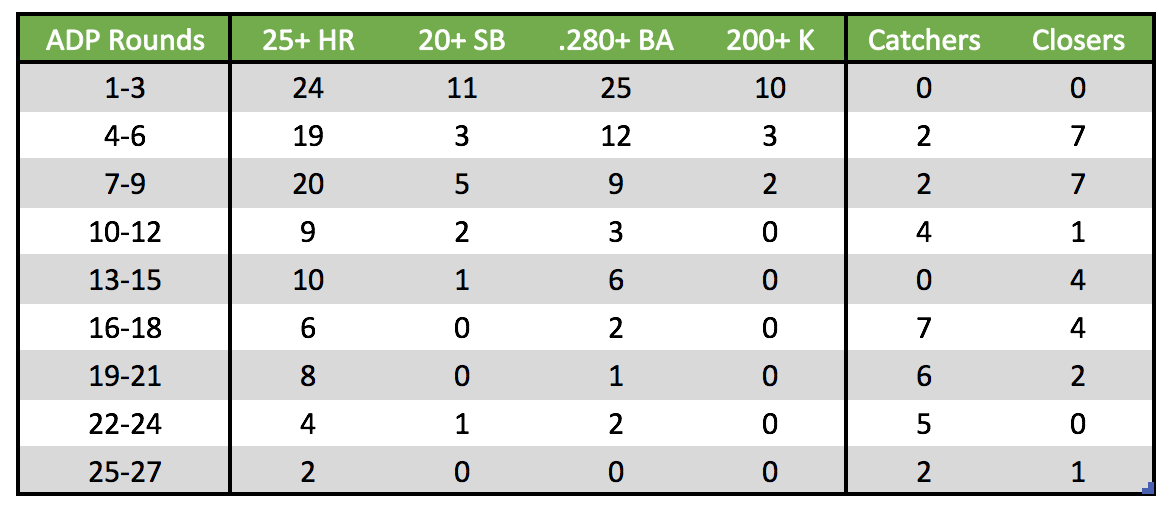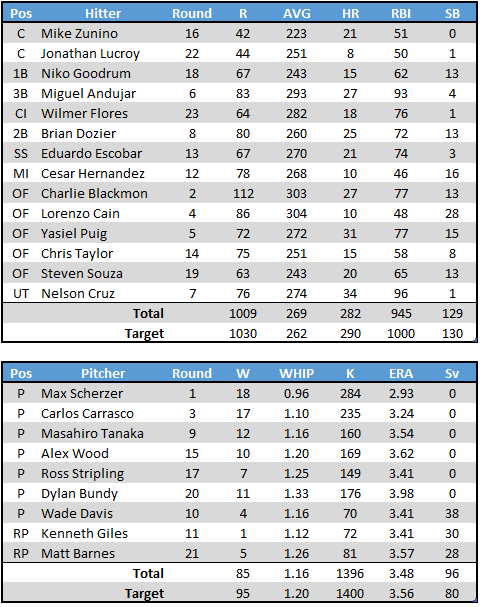
(*) ROTISSERIE: LABR Mixed—Pick a path, any path
I've always wanted to write one of these.
Since joining the BaseballHQ staff in 2012, getting an invite to one of the two premier industry leagues—LABR and Tout Wars—has always been a long-term, pie-in-the-sky goal. So I was stoked when Ray Murphy, who had been in the LABR Mixed league since its inception, asked in December if I wanted to take over for him this season. That was an easy yes (thanks again, Ray!), but once I came down off the high of the invite, I quickly pivoted: how do I win this thing?
•
For those unaware, LABR is a traditional format: 15 teams, standard 5x5, two catchers, and 6-man reserves. The draft took place on Tuesday night, but the planning began a few weeks back when I was handed the #6 pick in the draft.
Rather than just a pick-by-pick recap, we'll touch on a few things: 1) building a pre-draft checklist based on the trends of this year's player pool, 2) mapping out the many paths I could take with that sixth pick, and 3) seeing how it all panned out. Hopefully, this gives you some ideas to weave into your own prep for drafts later this month and into March. Onward!
Unlock all of our insights on your way to a fantasy title! See what our season-long coverage offers and then subscribe to BaseballHQ.com.
Player pool breakdown
Category scarcity is the new name of the game (outside of catchers and closers). Here's where the power, speed, strikeout, and batting average assets (per BaseballHQ.com projections) are going in drafts. I grouped the data into three-round buckets of the NFBC's Average Draft Position (ADP), which isn't perfectly aligned with a trading league like LABR, but at least highlights some notable trends in this year's player pool:

A few takeaways to help build my pre-draft checklist:
Grab 1-2 starters in the first three rounds: And yes, I did listen to the latest episode of BaseballHQ Radio. I agree that taking an early ace isn't a requirement—ultimately, picking the "right" pitcher trumps any general SP strategy—but our Santana Plan (2019 version coming soon!) contends that, on average, top-tier SP tend to return more value than any other type of pitcher:
The strategy works because over nine years, our Santana Plan anchors have returned 83% of their pitching value using a dollar allocation based on skills underlying the typical Rotisserie scoring categories, not actual outcomes, compared to only 52% for the pitching pool as a whole.
I'm also not a fan of many starters going in Rounds 4-6 this year, so if I get two early, I could skip that tier entirely and wait on a similarly-skilled SP in Rounds 8-10 to fill out the middle of my rotation. This would also allow me to...
Load up on power in the middle rounds: There are nearly as many power bats going in each of Rounds 4-6 and 7-9 as there are in the first three rounds. Sure, they might come with a weaker BA, fewer R/RBI, or no speed, but if I address those categories early, hitting power hard at this stage of the draft should balance things out.
Address speed early: The "20+ SB" column screams off the page: you need to address speed early this year. I don't think you don't need to bully speed early—leaving the draft with a middle-of-the-pack SB target is fine—but if you ignore speed completely in the first 3-4 rounds, you're likely trying to catch up with an "all eggs in one basket"-type approach that will set you back in other categories (i.e. Dee Gordon, Mallex Smith, Billy Hamilton, etc.)
Have one foot out of the catcher (cess)pool: This doesn't really affect my early-round planning, but it's important to have an idea of where catchers and closers are going in drafts. A notable tidbit on this year's catcher pool: There are no catchers being drafted between Yadier Molina (#8 C; 155 ADP) and Danny Jansen (#9 C; 235 ADP)... a 5+ round gap! If I don't grab a top-eight catcher, I'll be wading through the cesspool with both feet. That's no way to go through life.
Catch the closer run: I don't want to grab an elite closer too early, but in this age of split bullpens and a fracturing saves market, I'll want to grab one with a relatively stable role in Rounds 7-9-ish. I'll have my eye on a second closer around the 13th-14th, then lean on the eternal wisdom of Doug Dennis to navigate the in-season waters.
Pick a path, any path
With the checklist in place, it was time to map out my first few rounds. We've mentioned previously that there's a slew of options available in the middle of the snake this year. I narrowed it down to three guys, all with wildly different profiles: Max Scherzer, JD Martinez, and Christian Yelich.
There isn't a right or wrong answer here—you can build a team around the BA/HR combo of Martinez, five-category balance of Yelich, or pitching dominance of Scherzer—so my decision would come down to which team I can best construct around each anchor. After a few tweaks, I decided to give the color-coded draft chart that Ray debuted last week for a spin. Here's what my pick map looks like (numbers are $ values are LABR-specific generated by RotoLab):

I'm not married to the dollar values—note that no players are listed here—but it gives me a general idea of where talent starts to drop early in the draft. A few thoughts from the six-hole's point of view:
- Taking a SP by the 2nd round is a major decision in this draft, as a SP run will be coming after I make that pick (black outline above). Do I want to start that run with the SP of my choice (assuming I don't take Scherzer first), or take what the draft spits back at me in Round 3?
- There's a similar SP run coming around my fourth-round pick (purple outline). This tier has much less value and the two "power bats" going after that pick—Ozzie Albies and Gleyber Torres—aren't on my radar. I'm more interested in speed/balance picks like Lorenzo Cain, Tommy Pham, and Jean Segura; which affects my first three rounds.
With that, I mapped out my first four rounds with Scherzer, Martinez, and Yelich as my top pick. I don't want to pigeonhole myself into a certain player in a particular round, but with a one-minute timer, I need to quickly pivot to Plan B (or C). It also gives me an idea of which type of team I prefer:
--------------------------------SCHERZER PATH-------------------------------- Type $ Players Type $ Players ======== == ======= ======== == ======= Scherzer 38 Scherzer Scherzer 38 Scherzer Pwr/Bal 28 Blackmon/Stanton/Merrif Speed 28 Merrifield/Marte Spd/SP 24 Marte/Carrasco/Bauer Power/SP 24 Rizzo/Hoskins/Carrasco Spd/Bal 21 Cain/Segura/Pham Power 20 Suarez/Realmuto --------------------------------MARTINEZ PATH-------------------------------- Type $ Players Type $ Players ======== == ======= ======== == ======= Martinez 38 Martinez Martinez 38 Martinez Pwr/Bl/SP 28 Blackmon/Cole/Freeman Speed 28 Merrifield/Marte SP/Spd 24 Carrasco/Marte SP 22 Carrasco/Bauer/Severino Spd/Bal 21 Cain/Segura/Pham Spd/Bal 21 Cain/Segura/Pham --------------------------------YELICH PATH---------------------------------- Type $ Players Type $ Players ======== == ======= ======== == ======= Yelich 37 Yelich Yelich 37 Yelich Pwr/Bal 28 Blackmon/Stanton/Merrif SP/Bal 28 Cole/Blackmon SP 23 Carrasco/Bauer/Severino SP 23 Carrasco/Bauer/Severino Spd/Bal 21 Cain/Segura/Pham Power 20 Suarez/Realmuto
My preference with the sixth pick: Scherzer, Martinez, then Yelich. And I feel comfortable going into the draft with a plan should I be "forced" to take Yelich.
•
The Results
Turns out I didn't have to scheme all those Plan Bs and Cs (can I get those hours of my life back?), as the Baseball Forecaster coverboy was all mine with the sixth pick. The board played nicely in Rounds 2-4 as well; I was able to snag top pre-draft choices (Blackmon, Carrasco, and Cain) in each of those rounds.
You can view the full draft results grid here: http://www.rtsports.com/labr-mixed-draft. Here's the team I ended up with:
I drafted using my own version of the Mayberry Method (another column for another day) in lieu of just our projections, so my 2nd place finish in RotoLab was a pleasant surprise. I also got the "kiss of death", projected first place, from SiriusXM host Rick Wolf.
After 25 rounds @SiriusXMFantasy with Kyle Elfrink @BaseballGuys @glenncolton1 @SteveAGardner we have projected standings. @RyanBHQ @Stephania_ESPN @allinkid - are 1-2-3
ART ART OOOWWOOO pic.twitter.com/VSZoyaJSQi
— Rick Wolf (@RickWolf1) February 13, 2019
Let's return to that pre-draft checklist and see how I did:
1-2 SP in the first three rounds: I fully leaned into this one, going with Scherzer (1.06) and Carlos Carrasco (3.36) to sandwich Charlie Blackmon (2.25). My Scherzer draft maps had Starling Marte, Anthony Rizzo, and Carrasco in the third round; so when the first two were taken just ahead of me, I didn't hesitate to grab my second ace. I'd also put Masahiro Tanaka's (9.126) skills up against any of the starters going three to four rounds earlier.
Draft early speed: I did what I could, as I didn't get a shot at Marte in the 3rd, waiting until the 4th round to grab Lorenzo Cain. He's my only hitter projected for 20+ SB, but I chipped away at the SB mountain with six hitters projected for 10-20 bags.
Attack mid-round power: It turned out to be plentiful in this draft. After taking Cain in the 4th round, I picked four 25+ projected HR hitters in a row; two of whom, Yasiel Puig and Brian Dozier, can also provide some wheels.
Keep the pace with closers: Technically yes, but not how I expected it to go. I caught the tail-end of the first "full-time" closer run, double-tapping Wade Davis (10.145) and Ken Giles (11.156). I also took a speculative stab at potential BOS closer Matt Barnes in the 21st. Barnes' main competition for the role, Ryan Brasier, went one round earlier.
Avoid the catcher cesspool: Nope, both feet in the pool. Mike Zunino (16.235) and Jonathan Lucroy (20.295) have a pulse and they'll both play, which about all you can ask for that late. I could have taken Yadier Molina as the last of the "top tier" in the 11th, but decided to lock up Giles instead. Every team in a 15-team league will have holes.
A few final takeaways —
1) Take stock of your categories. I had a major batting average cushion early in the draft with a .286 projected BA through 11 rounds, which gave me a buffer to go for power/speed targets later on. Guys like Steven Souza, Niko Goodrum, César Hernández, and Mike Zunino (on the two-year anniversary of the Zunino Plan!) all helped balance out my hitting categories.
2) Everybody has a price. I've been "out" on guys like Gary Sánchez and David Dahl thus far; their early ADPs are too high, making them afterthoughts during my draft prep. Mistake. Sanchez (60 ADP) fell all the way to 99th overall to Jeff Erickson of RotoWire, two picks after I took Nelson Cruz. That's crazy value, and while I'm happy with Cruz, Sanchez could get a decent fraction of Cruz's BA/HR production at a much scarcer position.
3) Some luck always helps. I almost took Miguel Andujar instead of Yasiel Puig in the 5th round. Andujar fell all the way back to me in the 6th. Ditto for Ken Giles, who I almost grabbed in 9th instead of Tanaka. Not only did Giles make it back to me in the 10th, but I passed again and got him in the 11th. The fantasy gods can actually be on your side… sometimes.
The downside of LABR's early draft date is that I'll have to pray for six weeks that nobody here gets hurt. Someone go bubblewrap Scherzer and Carrasco until April—this team could be alright.








